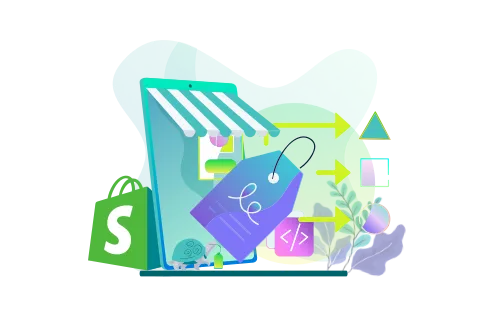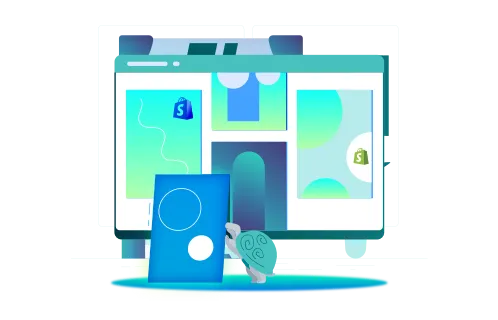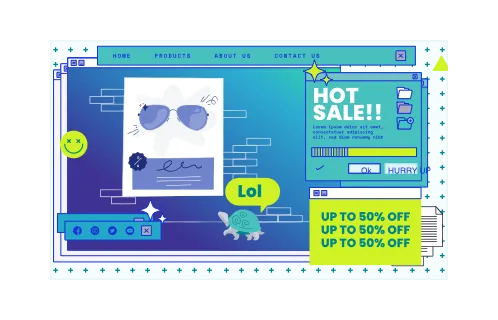You’ve found your craft, made a few batches of your products, and now, you want to distribute them online. But where exactly: Shopify vs. Etsy?
Choosing between these platforms can make or break your online success. Both offer unique strengths, but understanding their differences can feel paralyzing. Luckily, our guide is here to help you figure out:
- The main difference between Etsy and Shopify.
- The key features available on each platform.
- The subscription and transaction fees, along with other expenses.
- The use cases, pros, and cons of Shopify and Etsy.
By the end of this article, you’ll be sure which platform can move your business forward. After all, we’ve helped numerous companies like Valery Siurha Art choose (and even migrate) between these two solutions — and we can guide you, too.

Need help launching your brand on Shopify? Discuss your idea with our experts!
Table of Contents
- Shopify vs. Etsy: Brief Comparison
- Shopify vs. Etsy: Main Differences
- Etsy vs. Shopify: Key Features Comparison
- Etsy vs. Shopify: Pricing
- Shopify and Etsy: Pros and Cons
- Setting Up Shopify and Etsy
- Etsy vs. Shopify: Market Reach and Audience
- Scalability and Growth Potential of Shopify and Etsy
- Use Cases of Shopify and Etsy
- GenovaWebArt as Your Shopify Partner
- Conclusion
- FAQ
Shopify vs. Etsy: Brief Comparison
When deciding what’s best for your eCommerce business — Shopify or Etsy — you should consider several factors. Let’s quickly go through all of them:
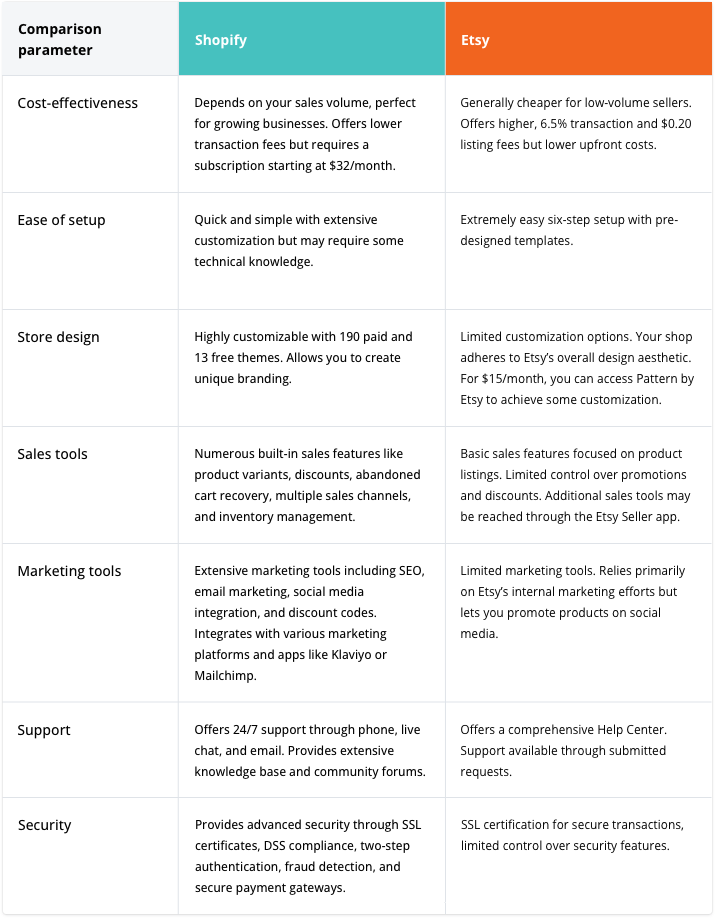
For more insights into other eCommerce platforms, check out our guide on Magento vs. Shopify.
Shopify vs. Etsy: Main Differences
The fundamental difference between Etsy and Shopify is their structure and purpose. Here’s an explanation.
Shopify is an eCommerce solution that lets you build your own online store from the ground up. It’s suitable for businesses of various sizes and features inventory management, payment processing, order fulfillment, and even marketing — on a single platform. With Shopify, you control your store’s design and functionality.
Etsy, on the other hand, is an online marketplace for selling handmade, vintage, and craft goods. It’s similar to a flea market. Etsy provides the platform and customer base, but you don’t have as much control over the design and features of your shop. You’ll need to follow Etsy’s guidelines and branding instead.
This difference significantly impacts how you sell. With Shopify, you establish your brand and attract customers to your store directly. Etsy lets you benefit from the existing audience but makes it harder to get noticed. This distinction is key when considering Etsy vs. Shopify for small businesses.
Etsy vs. Shopify: Key Features Comparison
Before you decide which is better Shopify or Etsy, consider the main features of both platforms. Here’s their detailed comparison:
Customization and Design
Shopify is undoubtedly the champion of customization. The platform offers numerous free and paid themes, letting you create a unique, branded online store. You can tweak everything from colors and fonts to the overall layout.
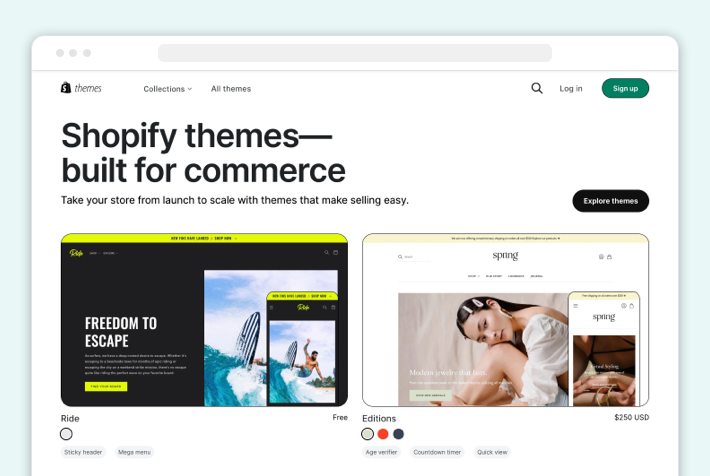
Etsy provides a simple shop layout that follows the overall platform’s style. While you can customize product listings with descriptions, photos, and titles, you have minimal control over your store’s look.
Ease of Use
When it comes to usability, both platforms have their perks, whether Etsy or Shopify. They are user-friendly and offer helpful suggestions as you grow and manage your store. There are certain distinctions, still.
Shopify provides smooth onboarding with a guided setup. It instructs you while you add products, manage inventory, and process orders. Yet, despite its intuitive interface, it does require some effort to learn due to its extensive features. Once you get the hang of it, managing your store becomes simple.
Etsy is even more beginner-friendly. To set up your shop, the platform asks you to go through only six simple steps, like naming your store and listing products. Since Etsy handles design, domain name, and functionality, getting started is way faster than with Shopify.
Integration and Add-Ons
Shopify offers an enormous selection of integrations and add-ons, over 8,000 of them. Owing to this, you can implement various tools to expand your store’s functionalities — think marketing automation or advanced analytics. And, for example, when comparing Shopify vs Etsy shipping solutions, the platform outperforms Etsy significantly.
So, what does Etsy offer? It provides some basic marketing, analytics, and shop management integrations, but Shopify offers more. You may also develop custom solutions using the Etsy API, yet this requires technical knowledge.
Customer Support
Shopify provides 24/7 support available through:
- Phone calls
- Live chat
- Specialist consultation (for Shopify Plus merchants)
Besides these options, the platform offers online tutorials, expert blog posts, and a helpful community forum.
Etsy provides support mainly through email requests and a discussion forum. But before you reach out for expert assistance, you may look up some of your questions in the platform’s Help Center.
Etsy vs. Shopify: Pricing
Now that we’ve explored both platforms’ features let’s get down to the Etsy fees vs. Shopify fees. Here are the pricing structures you should expect:
Shopify Pricing
Shopify offers four main subscription plans. They include:
- Basic. Features for individual entrepreneurs, available for $32/month.
- Shopify. Features necessary for small teams, available for $92/month.
- Advanced. Extended functionalities for scaling businesses, available for $399/month.
- Plus. All existing features for complex, enterprise-grade businesses, starting at $2,300/month.
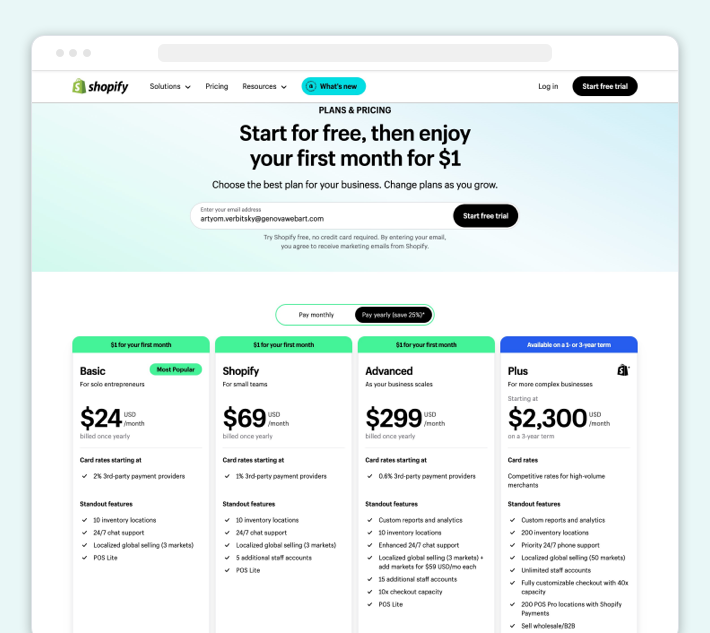
You’ll also face transaction fees if you leverage a third-party payment provider. They are 2% for Basic, 1% for Shopify, and %0.6 for Advanced pricing plans. Yet, if you use Shopify Payments as your payment gateway, expect no fees incurred.
Besides that, consider that you may require extra costs for a paid Shopify theme ($140 to $400) and premium Shopify apps.
Etsy Pricing
Comparing Shopify vs. Etsy fees, the latter charges on a per-sale basis. This includes:
- Listing fees. $0.20 for each product you add to your Etsy shop.
- Transaction fees. About 6.5% on the sale price of each item.
- Payment processing fees. Range by country but generally about 3%.
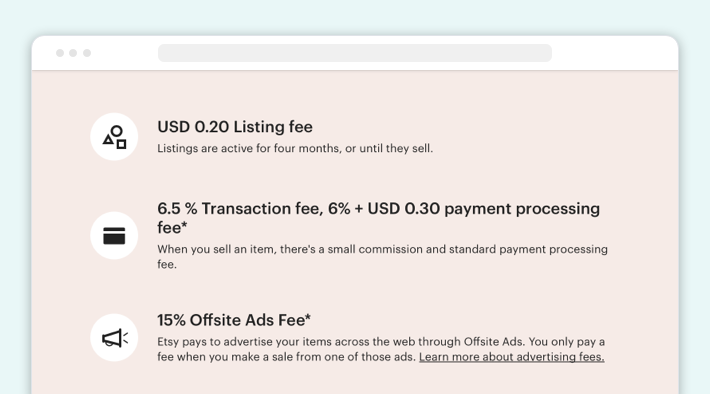
Etsy offers fewer subscription options, but the Etsy vs. Shopify fees are also lower. Here’s what you can choose from:
- Etsy Standard. Free-to-use, the default option for all shop owners.
- Etsy Plus. Offers increased customization and functionality for $10/month.
On top of that, you may want to use Etsy Pattern to create a website of your own and customize it to your liking. After the 30-day free trial, you pay $15/month.
To compare the prices of other eCommerce platforms, here’s our article on Shopify vs. Squarespace.
Shopify and Etsy: Pros and Cons
Let’s now analyze the pros and cons of Shopify vs Etsy, so you can make the best choice for your business.
Shopify Pros and Cons
The benefits of starting your business on Shopify include the following:
- Customization. Create an online store that fully reflects your brand.
- Scalability. Shopify is perfect for businesses of all sizes.
- Advanced features. The platform offers helpful built-in eCommerce functionalities and integrates with various apps and extensions.
- Unlimited products. Sell the desired number and types of products without restrictions.
- Omnichannel selling. Connect all your sales channels, even Etsy, to Shopify and sell across them easily.
While offering extreme flexibility, Shopify comes with several limitations. They are as follows:
- Customer reach. To attract customers to your store, you’ll have to invest in marketing.
- App costs. As your store grows, you may require more premium apps that add to your expenses.
Etsy Pros and Cons
Continuing to weigh out the pros and cons of Etsy vs Shopify, let’s look at Etsy’s advantages.
- User-friendly. With Etsy, it’s easier to set up and manage your shop, which is particularly relevant for those new to eCommerce.
- Established customer base. Access numerous potential customers by creating your shop on Etsy.
- Low barrier to entry. Not involving subscription fees makes Etsy attractive for beginner merchants.
There are also some limitations you should be aware of. They include:
- Limited customization. You may face difficulties in fully expressing your brand due to Etsy’s pre-defined marketplace format.
- Competition. Standing out in the market can be challenging, especially given the limited customization.
- Fees. Listing and transaction fees can add up quickly.
Setting Up Shopify and Etsy
If you’re ready to launch your online business, let’s look at the setup process for Shopify and Etsy.
Shopify
To set up a Shopify store, follow these steps:
- Sign up. Go to Shopify’s website and create a new account.
- Choose a plan. Select the Shopify pricing plan that best suits your needs. Think of the expected sales volume and desired features when making your choice.
- Add products. Use Shopify’s admin to add products and their details like descriptions, photos, and prices.
- Design your store. Use Shopify’s ready-made free or paid themes, or hire a designer to create a custom storefront for you.
- Configure settings. Set up a payment gateway, shipping methods, staff accounts, and beyond.
- Connect apps. Install apps or add-ons from the Shopify App Store to expand your store’s functionality if necessary.
- Test your store. Check if every feature in your store works properly and whether product descriptions are correct.
- Launch your store. Once you’re satisfied with everything, make your Shopify store live.
Pro tip!
Study this General Checklist by Shopify to make sure you cover every part of your new store.
Etsy
To get started with Etsy, go through the following steps:
- Create an Etsy account. Head to Etsy’s website and register a new account.
- Open your shop. Once you’ve created your account, use it to open your shop on Etsy. Enter the country you’re selling from, choose the currency, and come up with the shop’s name.
- List your products. Add product details like titles, descriptions, photos, and pricing. Set up shipping options as well.
- Configure payment info. Enter your bank card details to start receiving revenues from Etsy.
- Set up billing. Once you share your payment info with Etsy, you’ll have to choose suitable payment methods.
- Customize your shop. While customization is limited, you can personalize your shop banner, profile picture, and shop announcement.
Wondering how to get started with other eCommerce platforms? Read our detailed guide on Shopify vs. WooCommerce.
Etsy vs. Shopify: Market Reach and Audience
Beyond the setup process and pricing structures, knowing the audience and market reach of each platform is important for your business strategy.
As of 2024, Shopify is the most-used eCommerce platform out there. The Shopify market share is 23%, while other giants like WooCommerce and Magento boast only 14% and 8%, respectively. The platform can help you:
- Launch a business of any size and sell different types of products, even digital solutions.
- Reach customers worldwide using the tools for targeting your perfect buyer personas.
- Benefit from SEO, email campaigns, social media marketing, and paid advertising on various platforms.
To truly succeed on Shopify, you’ll need to build a strong brand identity and develop a relevant marketing strategy.
Etsy is a niche marketplace. As mentioned earlier, it’s best for selling handmade and vintage items. So, if your offerings include unique jewelry, artwork, clothing, or home decor, this platform might be the right fit.
Besides that, Etsy offers a large customer base. The platform had over 96 million buyers in 2023, which creates a significant pool of potential shoppers in your store. However, because of its “built-in” audience, your marketing is limited to optimizing product listings for Etsy search and using social media to attract traffic to your shop.
In case you’re aiming to use Etsy vs Shopify for small business, both platforms are solid options. However, consider your product type, target market, and marketing goals before choosing.
Still not sure which platform is right for you? Reach out to our experts and we’ll help you pick the best one following your needs.
Scalability and Growth Potential of Shopify and Etsy
As your business expands, the platform you choose needs to keep up with your ambitions. Let’s explore the scalability of both before you make your final decision — Shopify or Etsy.
Shopify is inherently built for growth. Here’s how it makes that possible:
- Features supporting growth. Shopify lets you sell wholesale and operate several sales channels and offers robust inventory management and order fulfillment services. It also integrates with automation tools easily, from CRM to marketing platforms.
- Top-notch performance. Shopify can handle high-traffic volumes and complex business needs.
- Enterprise solutions. Shopify Plus offers tools like Shopify Functions, advanced analytics, and fully customizable checkout to support large-scale operations.
Etsy is a perfect launchpad for your creative business, but its structure limits your large-scale growth.
- Growth potential. An existing, highly targeted audience is an undeniable benefit if you sell handcrafted or vintage goods. But if you aim to market manufactured products, it may not be the best choice.
- Scalability. Expanding your inventory and product range is challenging on Etsy.
Wrapping up, if you’re not an aspiring artist or a small startup just entering eCommerce, Etsy might not work for you. If you want to establish a legitimate business and direct it toward growth, Shopify may suit your needs better.
Use Cases of Shopify and Etsy
Having learned about the audience and scaling opportunities for launching Etsy shop vs Shopify store, it’s time to recap all the possible use cases of each platform.
Shopify is an ideal choice for:
- Businesses with a strong brand identity.
- Companies selling a wide range of products.
- Businesses targeting a specific customer niche.
- High-volume businesses.
- Businesses looking for advanced features and integrations.
- Merchants aiming to customize their online stores.
On the other hand, Etsy is a great fit for:
- Businesses selling handmade, vintage, and craft supplies.
- New businesses with limited resources.
- Businesses with a small product range.
- Entrepreneurs aiming to leverage Etsy’s existing audience.
Simply put, Shopify is well-suited for established and growing eCommerce brands, while Etsy caters to small businesses and hobbyists looking for an easy-to-use platform to sell their handicrafts.
GenovaWebArt as Your Shopify Partner
For over a decade, we’ve been designing, developing, and launching successful online stores. Even more than just stores — we create unique brands. Shopify is our best partner for that purpose, letting us go beyond mere product listings and deliver solutions that connect with customers on a deeper level.
More than 200 clients have already relied on our experience in:
- Shopify design and development. To get a custom Shopify theme, a bespoke Shopify app, or create a complex solution from scratch.
- Shopify expansion and scaling. To reach international markets, integrate APIs, or simply ensure their store is well-maintained.
- Shopify Plus. To access advanced features necessary for enterprise-grade stores.
- Migration to Shopify. To seamlessly transfer their stores to Shopify from Etsy, WooCommerce, Magento, and other platforms.
The Valery Siurha Art store is one decent example of what our efforts resulted in. Here’s how our collaboration happened.
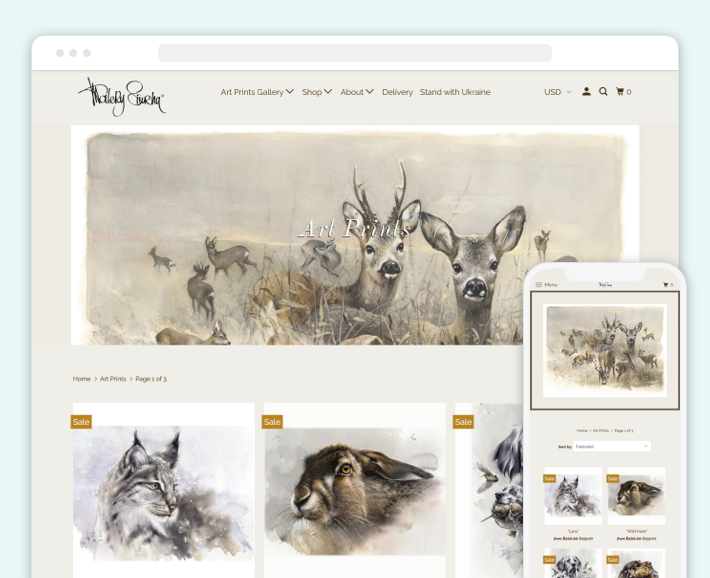
An artist, Valery Siurha, tired of Etsy’s limitations, partnered with us to create a custom Shopify store. We designed a website reflecting the brand identity and implemented it on Shopify. As a result, Valery got stronger branding, improved customer experience, and the freedom to grow his business as necessary.
Feel free to check out our entire portfolio for more inspiration.
Conclusion
The difference between Etsy and Shopify comes down to convenience versus control. Choosing Shopify lets you manage and customize your website limitlessly — no extra fees involved. While Etsy, with its extensive customer base, saves you on marketing.
Of course, the ultimate choice is yours. But remember that building your own store offers significant potential—better brand recognition, stronger customer relationships, and higher sales.
In case you’ve decided to establish your business on Shopify, feel free to reach out to our experts. GenovaWebArt is your reliable vendor ready to make a custom store for you.


![Shopify ERP Integration: Pros & Flow [2024] - GenovaWebArt blog article, banner image Shopify ERP Integration: Pros & Flow [2024] - GenovaWebArt blog article, banner image](https://genovawebart.com/hubfs/img/webp/hero-banner-blog-article-shopify-erp-integration.webp)
